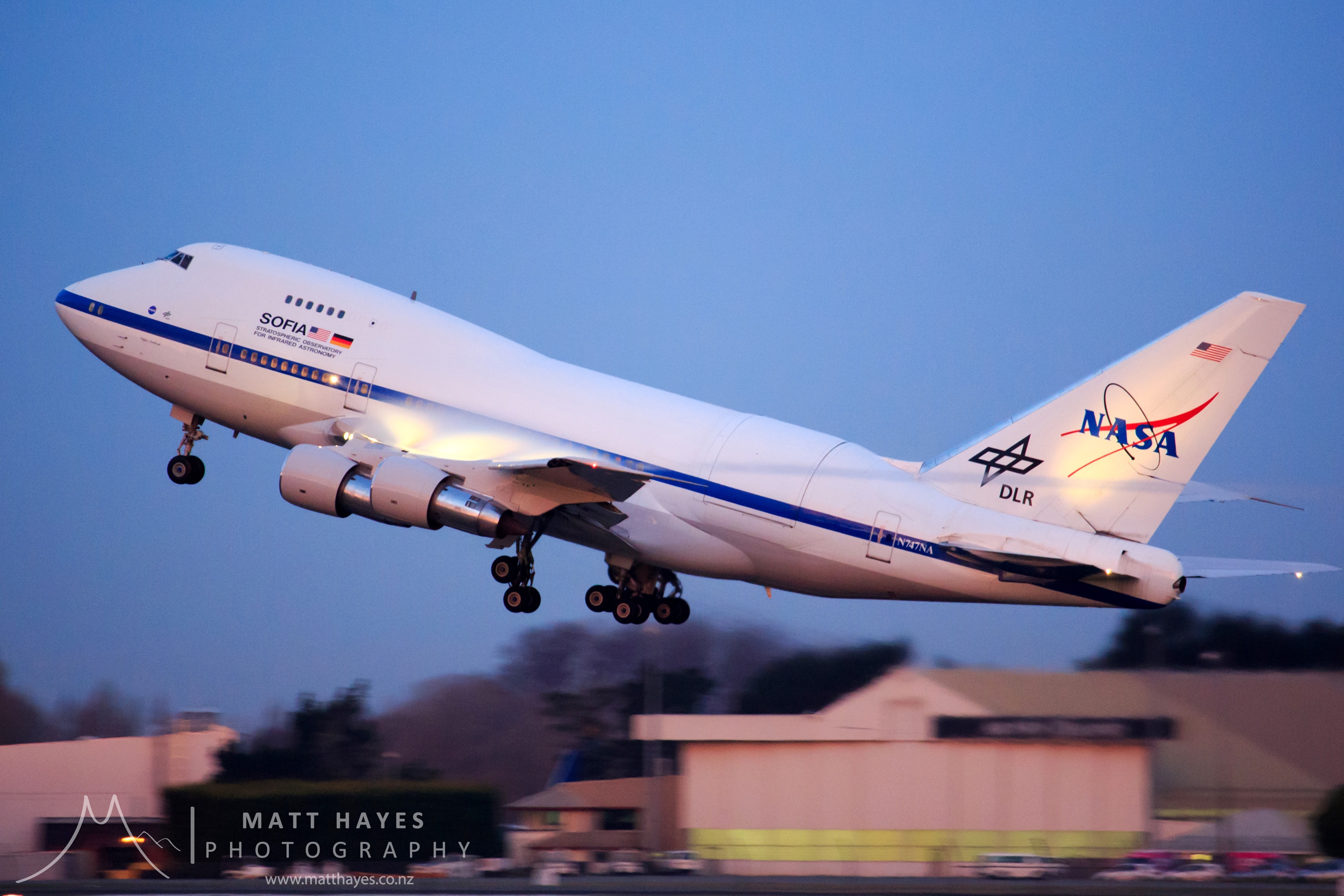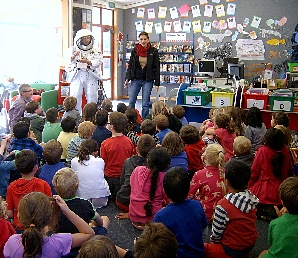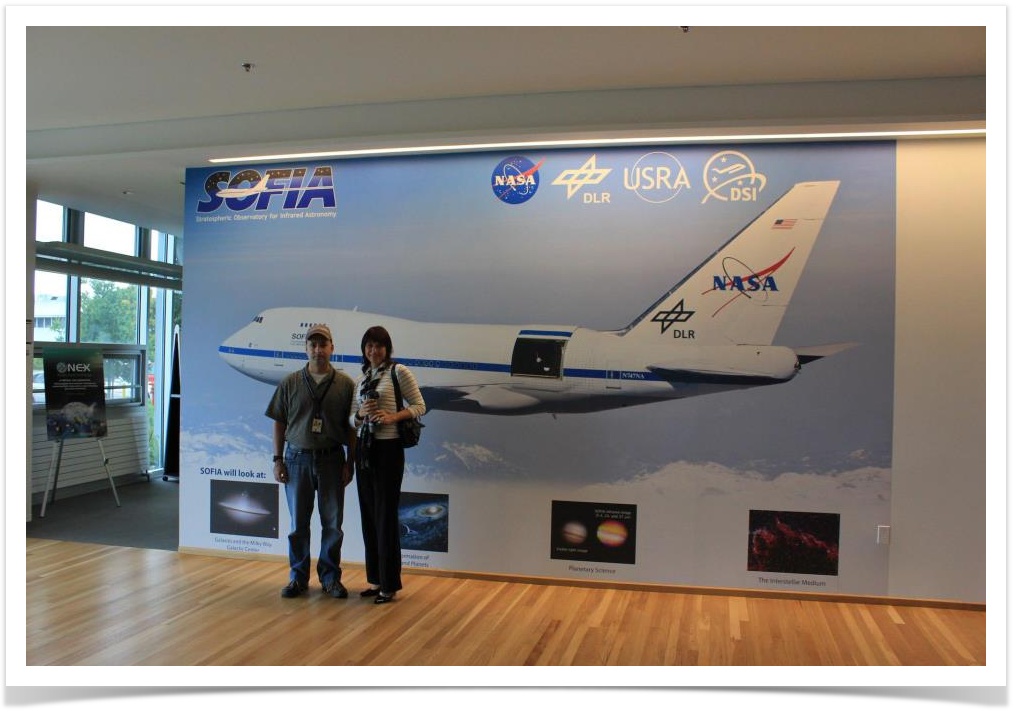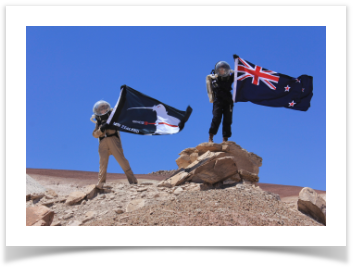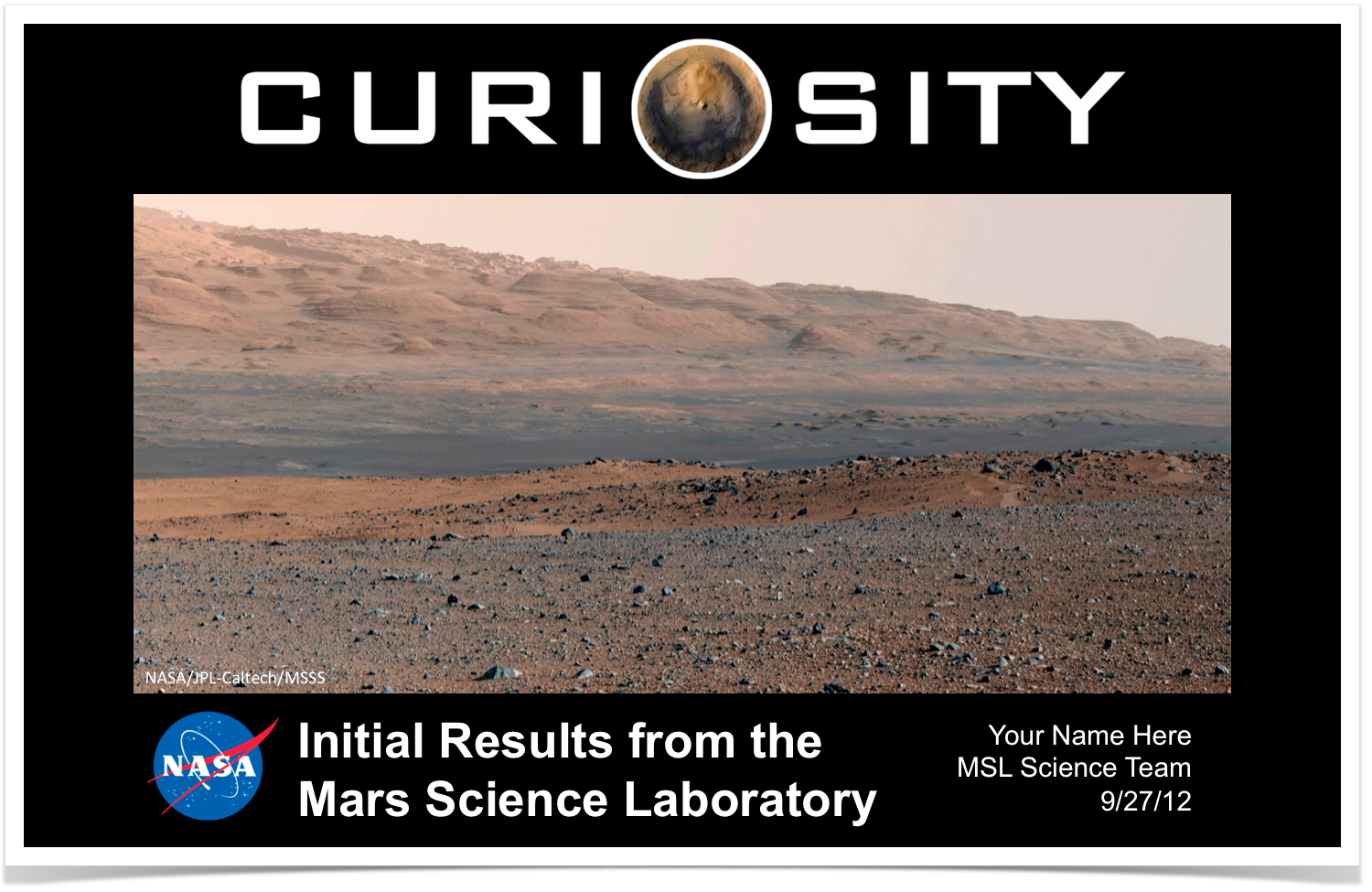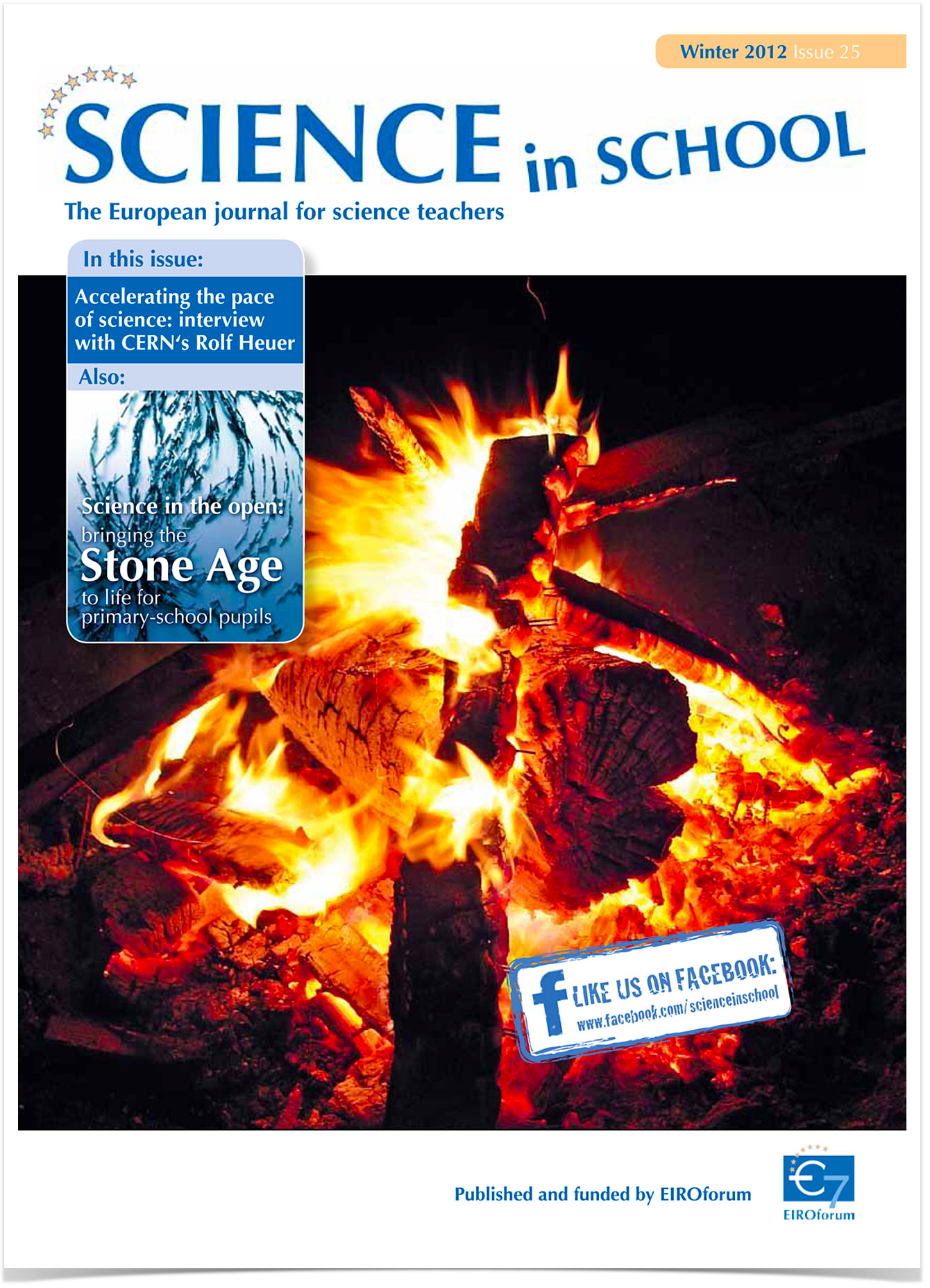In 2013, I had the great opportunity to interview the Chief Science Advisor of SOFIA, Eric Becklin whilst the flying telescope was here in New Zealand for its first southern deployment.
The circumstances of the interview itself could make it into a tale too, but suffice it to say that nothing stopped the story being told. As it seems nothing stopped SOFIA to fly either (1).
During the interview, Eric Becklin told us about the telescope, the aircraft, about why SOFIA is in New Zealand and Southern Hemisphere, the wonders of infrared astronomy, favourite discoveries and what he thinks about the future of humankind.
On a personal note, SOFIA’s Chief Science Advisor is a force of nature. He loves talking about SOFIA and his work with airborne astronomy, a project he holds very dear. Being around him and being shown around SOFIA was one of the highlights of my life, comparable only to how I felt on stage during my TEDx talk (Also in Christchurch!).
We hold the dream that SOFIA will one day be accessible to school teachers from New Zealand, who could become ambassadors of SOFIA. In fact, the reason for this interview was to bring SOFIA to the classrooms and to a wider audience from around New Zealand.
Now SOFIA is back in New Zealand and very soon there will be more stories about this wonderful flying telescope. Watch this space and until then, learn about SOFIA and its discoveries from this interview.
Special thanks
Kiwispace Foundation who sponsored my trip to Christchurch,
Eric Becklin, SOFIA team, Matt Hayes for the excellent pictures of SOFIA and my colleagues.
(1) “SOFIA was in danger of being mothballed when NASA’s 2015 budget request sought only $12.3 million for the project, down from $87.4 million in 2014. NASA said in the request that if it could not find partners to take over the agency’s share of operations, it would place SOFIA in storage in 2015. The omnibus bill instead provided SOFIA with $70 million, allowing the project to continue, although with 20 percent less funding than 2014.” – See more at: http://spacenews.com/kepler-and-sofia-survive-technical-and-fiscal-challenges/#sthash.HfzBWYFV.dpuf
Leading towards the Space Night event at Crofton Downs School in Wellington, on 20 June 2015 the children are very eager to find out what happened to the Impatiens seeds that have been to space. The seeds came all the way from JAXA courtesy of KiwiSpace and one of the batches has been to space on the International Space Station ISS.
They are also looking forward to recreate the 2013 space seeds experiment with azuki beans and will share their results at the Space Night.
You can find out more about the experiment or space night here: http://spacenight.friendsofcdps.org/?p=278
Haritina Mogosanu member of KiwiSpace Foundation on Thursday 30 April 2015 at Crofton Down School, explaining the Space Seeds project.
I visited SOFIA's realm at NASA AMES in April 2012 and meet some of the team working for IT . And just like in the fairy stories, I wished upon a star that I could see it for real for at least once in my life. Oh well...
SOFIA, which is the acronym for the "Stratospheric Observatory for Infrared Astronomy" landed in New Zealand today. It looks like it will spend some time with us from now on. SOFIA is a world class airborne observatory (in other words an aircraft with a telscope inside!) that looks at the visible, infrared and sub-milimeter spectrum. It is the legacy of the famous planetary scientist Dr. Gerard Kuiper (of the Kuiper Belt). SOFIA is now the largest airborne astronomical observatory as well as a test bench for a wide variety of astronomical instrumentation and detector technology.
Who would have thought... telescopes could fly, 400 years ago ... when Galileo first looked through one!!
I am looking forward to learn more about this amazing aircraft, and the contribution that it brings to the development of science.
Let's wish SOFIA a very warm welcome to New Zealand!
Click on this picture to see SOFIA Image Gallery
Links
- SOFIA Official page - NASA.gov
- "SOFIA Space telescope touches down" - Stuff.co.nz (14 July 2013)
- Southern Deployment 2013 Press Kit
- SOFIA Infographics
Greetings to those of you who will be part of the programme Seed For Space 2013. We just received word that today, students from Osaka City University came to Tsukuba Space Center to prepare flight samples for SSAF2013. The Azuki seed will be turned over to transportation team on Monday evening.
Three students prepared total of nine sets of rockwool blocks holding 18 seeds each. Five out of 9 blocks were selected and put into the plastic boxes. Among the five boxes, two were assigned for flight and back-up. Remaining three are reserves. Two will be sent to Tanegashima, then one goes to space and the other comes back to Tsukuba serving as the ground control. A detailed report will follow.
Jaxa is planning to have a rehearsal of the video file transfer. This rehearsal is very important to confirm that the video images of on-board operation will reach people timely. Detailed schedule will be announced later.
End of Transmission
P.S. - I was looking for a good picture of seed from space and came across this ... could not help it, I am a huge Star Trek fan
So why is Pluto not a planet anymore? You can download here a copy of my reply which was kindly edited (slashed ) by Duncan to fit the 150 words requested by the newspaper format.
Commander Hadfield is my personal hero and currently my favourite science communicator! I am so impressed about how he brought space back on Earth and made ISS very real, through his tweets, facebook posts, the pictures he took from space and the movies he made and all the rest. And then he shared them with us all.
But what Commander Hadfield shared every time was a tiny piece of himself. His thoughts and feelings and that made everything very personal and I could relate to it. Thanks to social media.
More links
The official blog of the Canadian Space Agency
Canadian Space Agency on Facebook
Chris Hadfield on Facebook
From http://www.phys.canterbury.ac.nz/starlightfestival/
Students in Years 5–8 and 9–13 are invited to submit an essay of not more than 600 words or a poem of no more than 40 lines by 12 August 2013.
Students are invited to choose one of these themes:
- I am inspired by stars in the night sky;
- What can we do about light pollution?;
- Darkness.
Prose or poetry can be imaginary, historical or scientifically based.
Judges will be looking for knowledge of the southern stars and either good research or imaginative use of astronomy.
Clearly expressed, grammatically correct English is expected.
The 10 best entries will win an exciting all-expenses-paid weekend at Tekapo, a kitset Galileoscope and a visit to the University Observatory at Mt John along with a Certificate presented by veteran NASA astronaut Marsha Ivins, who will be at the festival as a special guest.
For further information and how to enter please refer to the attached document and go to www.starlightfestival.org.nz.
The competition is part of the Aoraki Mackenzie Starlight Festival, organised by the Aoraki Mackenzie International Dark Sky reserve Board in partnership with the University of Canterbury.
Ten years ago I was sitting in a TV studio in Romania with a bunch of top scientists, talking about the space race. My producers were asking the rhetorical question why is it that the space race stopped, that countries don't seem to want to go to space, Moon or Mars as it was in the Apollo time?
I replied that I believed what happened prior to our discussion (aka people going to space) emerged from the cold war and it took off as a space race competition between the superpowers USA and USSR. And yes Kennedy was one of the greatest leaders to have had the vision to elevate the cold war to space - look at all that came with it: better communication, velcro, biosecurity, safer food. But when the cold war finished, the first thing "they" did was to dismantle the first (russian) space station MIR just because they could. And yet. I argued that it was just a matter of time until this will be picked up again by commercial endeavours, and I said that in the grand scale of the universe this was merely a moment.
I did not expect it to start back so soon!!
I believe that looking back to these ten-twenty years, humanity progressed enormously. We sent scientific instruments to space (Curiosity and all the rovers). We are genuinely interested on going on other planets and understanding the science behind them, because we are curious not because we have to compete in a war of some sort. So we kind of kept the flame burning but seeing people in space changes the challenge.
Human presence somewhere is such a milestone. The first human in Antarctica, the first human on the Moon, the first human to go to Mars!!!
There are a few organisations thinking of doing that currently:
Firstly let's start with NASA which estimates that it is not possible to put humans on Mars earlier than 2030. Here is a link to their human Mars programme http://mars.jpl.nasa.gov/programmissions/science/goal4/ NASA wants its people back home safely.
So does Inspiration Mars. The Inspiration Mars project http://www.inspirationmars.org is aiming to launch two astronauts in a historic flight around Mars and back to Earth launching in 2018.
But then, surprise, the very controversial Mars One project started recruiting for astronauts today http://mars-one.com for a one-way trip to Mars. Even CNN had issues believing this project, you can read all about the saga here: CNN Mars One article. It gives a very detailed account of what this expedition means. ""If humans land on Mars, everyone will want to watch," Mars One CEO Bas Landsorp said "It will be bigger than the Olympic Games." Which is why he say they will try and find some of the money from the income revenue of the reality TV show.
...
Rivers of ink and bytes will flow starting tonight and I cannot stop but being happy that we are thinking forward to this goal. And I hope humanity will be wise in choosing to go to Mars, will respect Mars and will respect live.
Some FAQ - we will add some more soon, so keep an eye on this space!
How an international crew put together by a dutch foundation will cope with ITAR, since all their supposed suppliers are from the US?
What is a launch window and how long do we have to wait for that to happen?
New Zealand Science Teachers Association was invited this year to send students to the 7th International Olympiad on Astronomy and Astrophysics, which will be held in Volos, Greece from 27 of July to 5th of August 2013.
Navodhi Depalchitra, Daniel Yska from Onslow College, Darina Kuhn from Wellington East Girls College and Connor Hale from Tawa College will be accompanied by Gordon Hudson, president of the Royal Astronomical Society of New Zealand.
We wish them a stellar time!!
All four students have demonstrated proficiency in practical Astronomy, are active members of the NZ Royal Astronomical Society, and have achieved highly in NCEA Physics and Mathematics. The level of competition will be high, as most other competing teams come from countries in which Astronomy forms a significant part of the secondary school curriculum. To counter this, the New Zealand students have been attending regular training sessions.
Fundraising for the expedition
Kind sponsors of the expedition are: the Royal Astronomical Society of New Zealand, Carter Observatory who very generously made available the Observatory for training sessions for the students and a fundraising planetarium show.
Ongoing fundraising:
- Planetarium show evening on Friday, the 19 of July (19:00 and 20:00 shows) at Carter Observatory.
- Pledge me page here
Why sending students to an Olympiad?
I strongly believe that our country, New Zealand has a great natural advantage (we could say with the best skies to train) and the intelectual capability to participate in international olympiads. At the end of the day almost every year New Zealand wins medals in the Biology, Geography, Mathematics, Chemistry and Informatics. It is time for a new star at the horizon: astronomy.
The project team would like to see this event transformed into a yearly one starting in 2013. Sending students to an Olympiad means that we are making sure they have equal opportunities for development, as any other students around the world. Most of the times, Olympiads entail lots of preparation and learning, in a country-large effort. However this year, due to the very short time available to organise, it would have to be a pilot programme for the subject of astronomy. For the future, we hope that the Olympiad syllabus could be integrated with the Curriculum for Planet Earth and Beyond. And hopefully, from next year, we will see a country wide competition in which students around New Zealand would participate to be selected for representing our country in the international Astronomy competitions.
A few highlights from the invitation:
About Olympiads
(excerpt from IOAA website)
Every year, international scientific organizations organize and conduct internationally, student Olympiads in various fields (Mathematics, Physics, Information Technology, Chemistry and Biology). Each country is represented by the students who have been selected after the competition, and who have subsequently been trained and prepared adequately to represent their country. It is the goal of every mission to honor his or her country by earning a medal or a distinction at the International Olympiad.
The Olympiad on Astronomy & Astrophysics was initially established with Aristotelian University of Thessaloniki professor John Seiradakis' initiative, who, during the general meeting of the International Astronomical Union held in Prague in August 2006, contributed to the implementation of this international event.
The competition is in 3 phases.
- Phase 1 entails the Theoretical Part. The students must solve 15 short problems and 2 long problems on Astronomy and Astrophysics (duration of exams: 5 hours).
- Phase 2 entails Data Analysis. Students are provided with real Astronomy-Astrophysics data and are required to solve 2-3d problems based solely on the data provided (duration of exams: 5 hours)1
- Phase 3 entails the Observational Part. Students are outside in the nighttime, (unless it is cloudy with little visibility and they are then inside a planetarium), and are required to answer questions pertaining to constellations, stars, the planets and the moon.
Why participate in an Olympiad? (IOAA view)
"The aim of the Astronomy Olympiad is to inspire and provide high school students with the opportunity to acquire knowledge in the sciences of the sky, i.e. Astronomy and Astrophysics. Through their participation in this international event, participants are given the opportunity to meet other students, from other countries, who have the same scientific interests as themselves. Additionally, cooperation between countries enables future scientific research.
The Olympiad, like all Olympiads, projects a country amongst scientific and academic circles and attracts high-level tourism (university professors, team leaders, observers and guests)."
According to the statutes of the Olympiad, all participating countries are obliged to undertake the organization of the Olympiad at least once. After the evaluation in 2010, Greece was proposed to host the organization of the Olympiad. In every Olympiad, each country is represented with maximum two leaders and five students. Observers and accompanying attendants are also welcome. To date, the average of participating countries has been 25, with numbers growing at a steady rate
Links
With thanks to David Wilson from NASA AMES who sent this to us.
A power point of the Curiosity's Initial Report was made available for the public.Here it is " Curiosity_Outreach_Oct2012.pptx " attached for you to enjoy!
It gives a good overview of the rover, of the landing sequence and of the sites planned to explored. Some early (now) measurement results are included as well.
The 25 edition just went live and you can find a link here: http://www.eso.org/public/announcements/ann12095/
"Science in School" touches on subjects from all areas of the curriculum.
Here are some of my highlights:
- How to use mathematics to study Jupiter's Moons http://www.scienceinschool.org/2012/issue25/galileo (for students aged 13-18)
- Science in the open: brining the Stone Age to life for primary school pupils http://www.scienceinschool.org/2012/issue25/stoneage (I always loved archery
this material also talks about how to make bows from branches)
I find it a great site, all yours to enjoy!
http://www.scienceinschool.org/categories
About ESO
ESO, the European Southern Observatory is an intergovernmental astronomy organisation in Europe and "the world's most productive astronomical observatory" they say. They conduct front-line science in the best conditions with a budget of approximately 131 million Euros per year.
ESO employs around 730 staff members. We meet two of them so far:
- Julian Girard in 2011 during the World Space Week when myself and Elf Eldridge interviewed him for our podcast http://www.worldspaceweek.org.nz/2011/event/64/podcast-03-julien-girard-astronomer-european-southern-observatory He works at the Very Large Telescope in Paranal. If you wish to find out more about the VLT, watching the movie "We Are Astronomers" at Carter Observatory is a great place to start!
- Oana Sandu in 2012 who sent us a most wonderful powerpoint on Outreageous Outreach for the Royal Astronomical Society of New Zealand at the 2012 conference in Wairarapa which I presented on stage. Here is Oana's site where you can find more useful information about astronomy communication and outreach. http://astronomycommunication.com/
All sky watchers know that there’s only one Lord of the Rings up there: the magnificent planet Saturn. But very few people realise that many of the mountains on its giant moon Titan have recently been named for fictional peaks in Tolkien’s books. Detailed mapping of Titan has been possible in the past few years through the joint NASA-European Space Agency space probe mission called Cassini.
In addition to a Mount Doom (a volcano according to the novels), there is now on Titan a Mount Erebor, the Lonely Mountain, where Bilbo and company travel to fight the fearsome dragon Smaug in The Hobbit.
Despite their origination in fiction, the names are still quite formal, the astronomers using Latin versions for the mountains. Avid Tolkien buffs will recognise Misty Montes as the Misty Mountains, which house the city of Khazad-dûm and also the Mines of Moria, where the dwarves dug too greedily and too deep, releasing the demon Balrog which slays Gandalf.
The mountains on frigid Titan, so far from the Sun, are not like terrestrial peaks. They are made of ice, water ice. The temperature way out on Titan is around –180°C, and not even the South Pole gets that cold on Earth. Titan, though, has some of the most Earth-like processes of any other body in our solar system. If it wasn't in orbit around Saturn it might be classified as a planet itself, being fully 40 percent the diameter of our own home, the third rock from the Sun.
Titan is the only moon in the solar system with a permanent atmosphere, unlike our airless companion. It also has lakes and rivers, but not of water, which is all frozen solid out there: what we see flowing on Titan is liquid methane and nitrogen! Titan is truly an unusual and spectacular world.
Titan’s mountains, ranging up to 1.5 km (or almost a mile) high, have continually formed and reformed as that moon slowly cools, gradually releasing heat from the time of its formation over four billion years ago. Its outermost ice crust has thickened and folded, as it shrivels up like a raisin. Some of these ‘creases’ have resulted in vast chains of peaks: Echoriath Montes, the Latin name derived from Tolkien’s Echoriath (or Encircling) Mountains, is 930 km long. Erebor Mons is 50 km in diameter.
Deposits of some sort of bright, white material – thought to be methane ‘snow’ or exposures of some other organic (carbon-bearing) materials – lie at the top of the mountain ridges, making them appear somewhat like the Southern Alps.
Titan is proving to be an amazing world which may hold the key to how life started, or may even be a host for extraterrestrial life: only microbes though, we’re pretty sure there are no ‘little green men’ on Titan!
Clear skies!
Haritina Mogosanu
Education Coordinator, KiwiSpace Foundation
Publicity Officer, Royal Astronomical Society of New Zealand
With thanks to Titan Saturn's Moon on Facebook and Duncan Steel
Additional information:
http://www.carterobservatory.org/ (More details about Titan you can see in the 'Wildest Weather of the Solar System' planetarium show)
http://www.lpi.usra.edu/features/titan_mt/
http://www.jpl.nasa.gov/news/news.php?release=2010-266
http://spaceref.com/missions-and-programs/nasa/cassini/saturn-and-titan.html
??? Bronwyn Holloway-Smith creator of the Pioneer City inspires students to explore their own Martian vision
Read more about this here:
http://bronwyn.co.nz/2011/09/08/pioneer-city-at-room-11/
Join us at Carter for some fantastic stories from across the world celebrating the Summer Solstice!
Carter is celebrating the longest day of the year on 21 December! Hooray for Summer.
We hope you will come and join us.
Please note that bookings are essential, so please contact our Front of House team on 04 910 3140 or info@carterobservatory.org to book in.
|
Carter Observatory |
|
NEW ZEALAND’S PLACE FOR SPACE |
